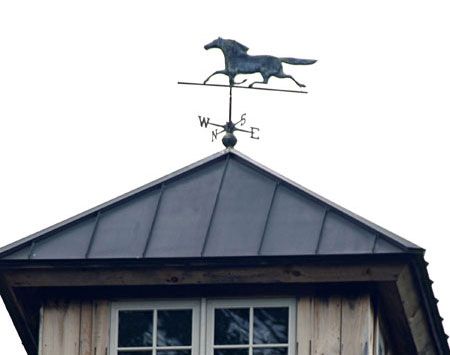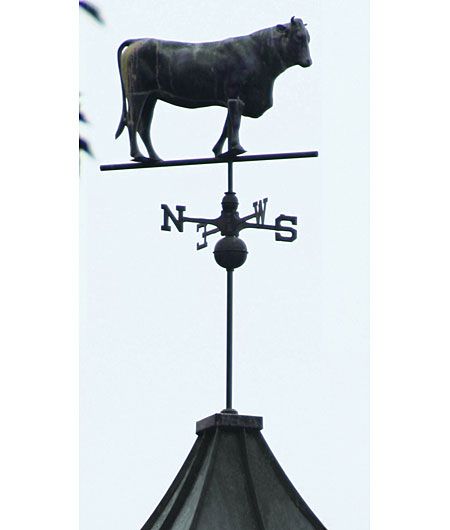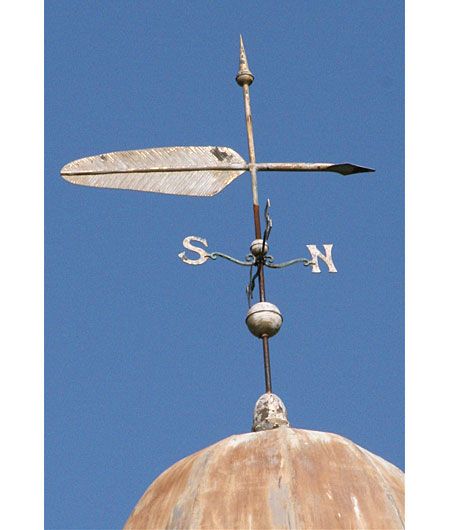
Weathervanes have been a staple of American architecture for centuries, serving both functional and decorative purposes. They help predict weather patterns and add charm and character to homes, barns, and other structures. Below, we explore weathervane history and options, plus provide tips on choosing, installing, and maintaining these iconic rooftop fixtures.
Origins of Weathervanes in America
Weathervanes first appeared in America as early as the 1600s, but they gained widespread popularity in the late 1800s. During this time, national manufacturers began producing copper weathervanes on a large scale, making them more accessible to the general public. These early American weathervanes often featured designs that reflected the country’s rural roots and maritime heritage.
How Weathervanes Work
Weathervanes rotate freely on a vertical rod, with the arrow or ornament pointing into the wind. The cardinal points—north, south, east, and west—are typically below the rotating portion. Traditionally, installers used a compass to set the cardinal points when positioning a weathervane accurately. By observing the direction of the wind, early colonists could predict weather patterns, as prevailing winds often brought specific conditions to their region.
Types of Weathervanes
Weathervanes come in more styles and designs than you may realize, reflecting various aspects of culture and history.
Agricultural Symbols

Many weathervanes feature agricultural symbols, paying homage to America’s farming heritage. Common motifs include the following:
- Roosters and chickens
- Horses and other farm animals
- Farm equipment such as plows or tractors
- Crops such as wheat or corn
These designs were particularly popular for barns and rural homes. They served as both functional tools and decorative elements that celebrated the agricultural way of life.
Education Indicators

A weathervane in the shape of a quill, a typical writing instrument of the 18th century, often indicated a writer or statesman lived at the home. Weathervanes weren’t only a way to observe weather but to also represent the skills and accomplishments of the owner.
Professional Signs

Weathervanes often incorporated signage for a tradesman, inn, or shop. This hammered metal vane marks “Hapwood Lodge” and includes a stylized tree, suggesting the area may be known for its woods.
Nautical Designs
Coastal regions often favored weathervanes with maritime themes. Popular designs include the following motifs:
- Ships and sailboats
- Whales and fish
- Mermaids and sea creatures
- Lighthouses and anchors
These maritime-themed weathervanes celebrated the rich seafaring heritage of their regions.
Considering Your Home’s Style
When choosing a weathervane, try to complement your home’s architectural style. An ornate, detailed weathervane is perfect for a Victorian-style house, while a sleek, simple design complements a modern home.
Matching the weathervane’s material to existing exterior elements, selecting a design that reflects your home’s era or style, and considering how it will appear against your roof and the sky will help in making the right choice.
Selecting the Appropriate Size
The size of your weathervane should be proportional to the building it adorns. Here’s a general rule of thumb:
- Buildings up to 2,500 square feet: 18–24-inch weathervane
- Buildings 2,500-3,500 square feet: 24–30-inch weathervane
- Buildings over 3,500 square feet: 30–60-inch weathervane
The weathervane should be visible from the ground without overwhelming the structure.
Choosing the Best Material and Color
Weathervanes are available in various materials that come with benefits:
- Copper: Develops a beautiful patina over time
- Brass: Maintains a golden shine
- Aluminum: Lightweight and resistant to corrosion
- Steel: Durable and can be painted
Copper and brass weathervanes are famous for their natural aging process. For painted options, consider colors contrasting with your roof for better visibility.
Installing and Maintaining Your Weathervane
Choosing the right location helps with both functionality and aesthetics. Your weathervane should be placed on the highest point of your roof or structure to allow ample space to catch the wind. Make sure there are no nearby obstacles, such as trees or taller buildings, that could impede its rotation. Decide whether you prefer it as a central focal point or an accent piece to complement other architectural elements.
Proper Installation Techniques
To install a weathervane correctly, choose a high, unobstructed location on your roof. Secure the mounting bracket to a structural support, then use a compass to align the directional arms accurately. Make sure the vane can rotate freely without obstruction. Consider adding a lightning rod if your weathervane is the highest point on your roof.
We recommend hiring a professional for complex installations or steep roofs.
Maintenance and Preservation Tips
To keep your weathervane in top condition:
- Clean it annually with mild soap and water.
- Check for loose parts or signs of wear.
- Apply a clear protective coating to painted weathervanes.
- For copper or brass vanes, decide whether to maintain the shine or allow the natural patina to develop.
- Lubricate moving parts with a silicone-based lubricant as needed.
Collecting Antique Weathervanes
For enthusiasts and collectors, antique weathervanes can be valuable pieces of Americana and folk art.
Identifying Authentic Pieces
When collecting antique weathervanes, look for signs of age and wear consistent with the purported era, as well as handcrafted details and imperfections that indicate authenticity. Pay attention to the original paint or patina, which can add value and confirm the piece’s age. Maker’s marks or stamps from known manufacturers are also important indicators of authenticity.
Valuing and Caring for Collectibles
Several factors influence the value of an antique weathervane, including its age, rarity, condition, originality, historical significance, artistic merit, and craftsmanship. Proper care maintains the value of collectible weathervanes. They should be stored in a climate-controlled environment, handled with clean, dry hands or gloves, and cleaned gently to preserve the patina.
Consult a professional conservator for restoration. Understanding each piece’s historical context and background can enhance its appreciation and value. Engaging with fellow collectors and experts in the field can provide valuable insights to further enrich your collection.
Modern Innovations in Weathervane Design
While traditional designs remain popular, modern weathervanes incorporate new technologies and customization options.
Solar-Powered and Lighted Weathervanes
Some contemporary weathervanes feature solar-powered lighting for nighttime visibility, LED displays showing wind speed and direction, or integration with home weather stations. These high-tech options combine traditional charm with modern functionality. Imagine your weathervane illuminated at night.
Custom and Personalized Options
Many manufacturers now offer customization services, allowing homeowners to create unique designs reflecting personal interests, incorporate family crests or logos, choose specific color combinations, and opt for miniature versions for smaller structures or garden decor.
These personalized weathervanes add a distinctive touch to any property. Custom weathervanes make a unique statement, whether it’s a beloved pet, an emblem of a cherished hobby, or a meaningful emblem.
